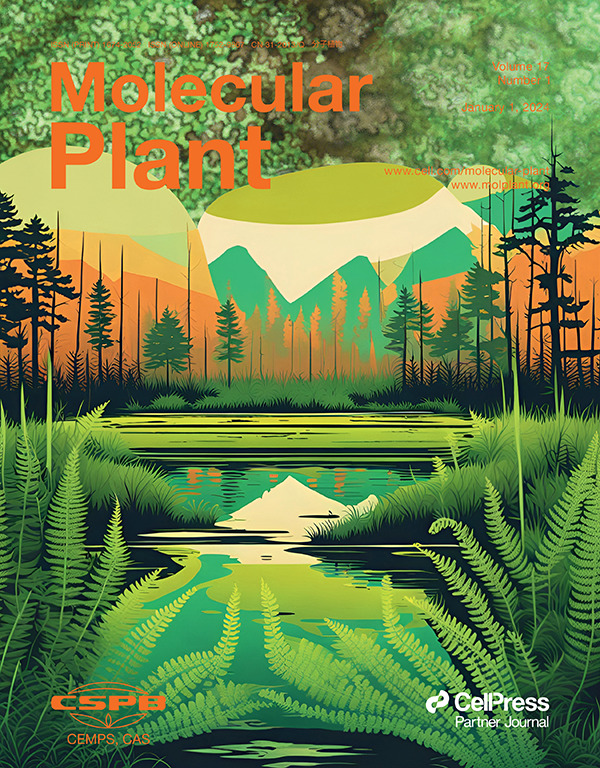The chloroplast translocon subunit TOC33 relays singlet oxygen-induced chloroplast-to-nucleus retrograde signaling in Arabidopsis
IF 24.1
1区 生物学
Q1 BIOCHEMISTRY & MOLECULAR BIOLOGY
引用次数: 0
Abstract
Chloroplasts engaged in oxygenic photosynthesis frequently overproduce reactive oxygen species (ROS) under stress conditions, with singlet oxygen (1O2) being particularly harmful due to its high reactivity and short lifespan. The nuclear-encoded chloroplast protein EXECUTER1 (EX1) senses elevated 1O2 levels through Trp643 oxidation and undergoes proteolysis, a process essential for activating 1O2-induced EX1-mediated chloroplast-to-nucleus retrograde signaling (1O2-EX1 signaling). However, the link between EX1 proteolysis and subsequent nuclear transcriptome changes remains unclear. In this study, we isolated SOF1 (suppressor of flu 1) through a forward genetic screen using EMS-mutagenized flu mutant seeds of Arabidopsis thaliana harboring Flag-fused EX1 driven by its native promoter (referred to as fluEX1). Like flu, fluEX1 plants conditionally produce 1O2 in chloroplasts upon a dark-to-light shift. In the fluEX1 sof1, all 1O2-induced stress responses are largely suppressed, despite 1O2 levels being similar to those in the fluEX1. SOF1 encodes the chloroplast outer envelope-anchored preprotein import receptor TOC33. While TOC33 loss does not affect EX1 import, abundance, localization, and 1O2-induced proteolysis in the chloroplast, it blocks 1O2-induced chloroplast-to-nucleus retrograde signaling. TOC33 interacts with the UVR domain of EX1 (EX1-UVR) in the chloroplast envelope, facilitating 1O2-induced decrease of the chloroplast EX1-UVR and increase of the nucleus EX1-UVR. Moreover, ectopic expression of EX1-UVR outside of the chloroplast bypasses the restrictive barrier imposed by the chloroplast envelope, activating 1O2 signaling and inducing stress responses. Our findings demonstrate that SOF1/TOC33 mediates 1O2-EX1 signaling from the chloroplast to the nucleus and that the EX1-UVR domain can substitute for full-length EX1 in this signaling pathway.叶绿体转位亚基TOC33在拟南芥中传递单线态氧诱导的叶绿体到细胞核的逆行信号
在胁迫条件下,叶绿体进行含氧光合作用时,往往会过量产生活性氧(ROS),其中单重态氧(1O2)的反应活性高,寿命短,危害特别大。核编码的叶绿体蛋白EXECUTER1 (EX1)通过Trp643氧化感知1O2水平升高,并进行蛋白水解,这是激活o2诱导的EX1介导的叶绿体到细胞核逆行信号(o2 -EX1信号传导)所必需的过程。然而,EX1蛋白水解与随后的核转录组变化之间的联系尚不清楚。在这项研究中,我们利用ems诱变的拟南芥流感突变种子,通过正向遗传筛选分离出SOF1(流感1的抑制因子),其中含有flag融合的EX1,由其天然启动子(称为fluEX1)驱动。像流感一样,fluEX1植物在从暗到光的转变中有条件地在叶绿体中产生1O2。在fluEX1 sof1中,尽管氧水平与fluEX1相似,但所有o2诱导的应激反应都在很大程度上被抑制。SOF1编码叶绿体外包膜锚定的前蛋白输入受体TOC33。虽然TOC33缺失不会影响叶绿体中EX1的输入、丰度、定位和o2诱导的蛋白质水解,但它会阻断o2诱导的叶绿体到细胞核的逆行信号传导。TOC33与叶绿体包膜中EX1的UVR结构域(EX1-UVR)相互作用,促进o2诱导的叶绿体EX1-UVR的降低和细胞核EX1-UVR的增加。此外,EX1-UVR在叶绿体外的异位表达绕过叶绿体包膜的限制性屏障,激活1O2信号并诱导胁迫反应。我们的研究结果表明,SOF1/TOC33介导了从叶绿体到细胞核的o2 -EX1信号通路,并且EX1- uvr结构域可以在该信号通路中替代全长EX1。
本文章由计算机程序翻译,如有差异,请以英文原文为准。
求助全文
约1分钟内获得全文
求助全文
来源期刊

Molecular Plant
植物科学-生化与分子生物学
CiteScore
37.60
自引率
2.20%
发文量
1784
审稿时长
1 months
期刊介绍:
Molecular Plant is dedicated to serving the plant science community by publishing novel and exciting findings with high significance in plant biology. The journal focuses broadly on cellular biology, physiology, biochemistry, molecular biology, genetics, development, plant-microbe interaction, genomics, bioinformatics, and molecular evolution.
Molecular Plant publishes original research articles, reviews, Correspondence, and Spotlights on the most important developments in plant biology.
 求助内容:
求助内容: 应助结果提醒方式:
应助结果提醒方式:


